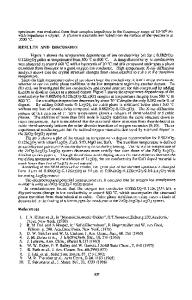Microstructural observations of pressure cast Ni 3 Al/Al 2 O 3 and Ni/Al 2 O 3 composites
- PDF / 2,724,968 Bytes
- 8 Pages / 597.28 x 785 pts Page_size
- 84 Downloads / 421 Views
INTRODUCTION
I.
R E L A T I V E L Y low melting point metals, reinforced with continuous ceramic fibers, are now readily produced by pressure casting techniques. IL2'31 Extending these techniques to higher melting point matrices, for use at elevated temperatures, has offered considerable difficulties. However, recently, these problems have been overcome, and pressure casting of Ni3A1//AI203 and Ni/AI203 composites has been successfully carried out. t4'51 We report here on metallo--aphic observations of fibers, matrices, and interfaces of these pressure cast composites.
II.
PROCEDURE
Infiltration of ceramic fiber preforms by liquid metal does not take place spontaneously, because molten metals do not usually wet these fibers. Therefore, it is necessary to apply external pressure to overcome various resistances to infiltration. The procedure by which this was done in the present work has been described elsewhere. 14,51In brief, the chamber was first evacuated. Then, metal and fiber preforms, at separate positions, were simultaneously heated to desired temperatures. The molten metal was introduced onto the preform, and argon gas pressure was slowly applied until 3 MPa was reached. Both composite rods (9.5 m m diameter and 150 mm long) and disks (50 m m diameter and 12.5 m m thick) were cast. The data reported here are from disks. A plot of the fiber and metal temperatures as a function of processing time is given in Figure 1. Also shown is the applied gas pressure as a function of time. The
S. NOURBAKHSH, Associate Professor, H. MARGOLIN, Professor, and F.L. LIANG, Postdoctoral Research Fellow, are with the Department of Metallurgy and Materials Science, Polytechnic University, 333 Jay Street, Brooklyn, NY 11201. Manuscript submitted October 19, 1988. METALLURGICAL TRANSACTIONS A
casting temperature for both the Ni3AI alloy and Ni was 150 ~ above their respective melting temperatures of 1390 ~ and 1450 ~ For the Ni3AI matrix, the fibers were heated to 1550 ~ and for the Ni matrix, the fibers were heated to 1600 ~ Both DuPont FP o~-A1203 and PRD166 a - A 1 2 0 3 , c o n t a i n i n g 20 wt pct partially stabilized ZrO2 fibers, were employed. The fibers were received in preform assembly, containing 50 vol pct fugitive binder, which was burned off by heating in air at 700 ~ for five hours. The fibers were 20/.~m in diameter. The Ni3A1 material was obtained from Oak Ridge National Laboratories and was designated IC218. This alloy contains, in weight percent, 8.5 A1, 7.8 Cr, 0.8 Zr, 0.02 B, and a balance of Ni. The unalloyed Ni was 99.99 pct pure. To enhance wetting of the fibers, approximately 1 wt pct Ti was added to the IC218 and the Ni. 14~ The Ti is added separately and becomes incorporated into the matrix alloy during melting. For optical microscopy, samples were cut from the composite disks by a diamond cutoff wheel along a plane normal to the fiber axis. The samples were prepared for examination by grinding through 600 grit papers, were then polished with 0.25/~m diamond paste, and were finally polished with
Data Loading...











